This article describes a common overheating laptop scenario along with a fix that works.
Overheating laptop and related shutdown problems are very common in notebook computers, especially in home use. Common symptoms of laptop overheating include some or all from this list;
- Laptop is extremely hot to the touch, especially around the fan exhaust area
- Laptop fan is constantly running at high speed
- Laptop shuts down by itself when doing nothing
- Laptop shuts down when playing games
- These laptop overheating or shutdown problems become worse over time, rather than getting better.
In around 1 in 10 cases of laptop overheating, there is potentially a phyical fault with the cooling hardware.
By this I mean either a mechanical failure with the fan where it can no longer spin, or it spins too slowly, or a motherboard electrical fault which exhibits itself by not telling the fan to spin fast enough to cool the laptop.
In these cases, the fan is spinning as fast as it can, but if the hot air is obstructed from reaching the outside world, a heat build-up occurs and the laptop takes the safety precaution of turning itself off, rather than allowing permanent damage to occur.
I will very quickly explain how a laptop cools itself.
Heat from the CPU, and sometimes the graphics chip, is conducted away from the processors via strips of copper metal. At the far end of this copper heatsink, the heat is fed into a series of side-by-side metal fins. This grill provides a very large surface area for the heat to be spread over.
A fan then draws air from the outside world and blows across the hot grill, back towards the outside. As it does so, the air picks up heat from the hot metal fins and takes it away from the laptop.

The fan will be drawing in cool air from the outside world through vents in the bottom or sides of the laptop and occasionally there might be a tiny piece of fluff, hair or dust sucked in with the cool air.
When this air is being blown across the hot metal grill, the airborne material can get stuck on the front of the metal fins if it is large enough.
If this keeps happening over time, gradually more and more material will build up on the front of the grill, creating an obstruction.
A common example of this buildup of material is shown in the image to the left. All of that grey furry material is a combination of dust, lint, hair or fluff that has been compacted on to the front of the heatsink grill.
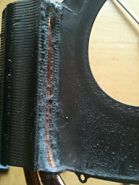 The effect of this is to block some of the airflow over the heatsink grill. With less physical space for the air to get through, the air is not picking up heat from the whole set of fins.
The effect of this is to block some of the airflow over the heatsink grill. With less physical space for the air to get through, the air is not picking up heat from the whole set of fins.
So a smaller amount of heat is transferred to the air in it’s journey to the outside world. With less heat being removed, the heat starts to build up inside the laptop (overheating).
Temperature sensors detect this and will react by making the fan spin faster and faster. The point of spinning the fan faster is to force more air through the available gaps, and past the hot metal fins to pick up more heat.
This compensation of spinning the fan faster can work to an extent, but eventually a limit will be reached. If the heatsink grill is sufficiently blocked, the fan will be spinning at maximum speed and it will no longer be possible to reduce, or even stabilse, the internal temperature of the laptop.
Temperature sensors will realise this and as a final failsafe protection measure the laptop will power itself off. The hope behind this is that if the CPU is no longer producing more and more heat, the existing internal heat will gradually dissipate of it’s own accord and the laptop will, hopefully, avoid serious damage.
To fix this problem, you need to strip the laptop down to allow access to the heatsink and fan(s).
I’m not going to explain how to strip down a laptop, step by step, as there are guides elsewhere explaining this in detail, and some manufacturers, for example Dell, even provide Service Manuals on the support pages of their website.
In most cases, to disassemble a laptop, all you will need are one or two small screwdrivers.
Some laptops require special torx screwdriver heads to remove some of the internal screws, so you will need to investigate this in relation to your particular laptop make and model.
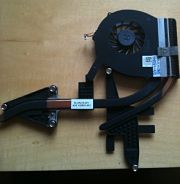
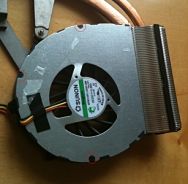 The pictures I have taken for this post were from an overheating Dell Vostro 3700 laptop.
The pictures I have taken for this post were from an overheating Dell Vostro 3700 laptop.
It would shut itself off after about 15 minutes of average use. It was extremely hot to the touch around the fan area, and the overheating problem had gotten progressively worse over time.
The Dell Service Manuals explained how to remove the heatsink / fan assembly.
In this overheating laptop, the fan was mounted on to a plate so I removed the screws holding the fan. I’ve circled the tiny screws for easy identification.
The top image in this post shows the build-up of dust on the front of the heatsink fins. In fact, it also goes to show that you don’t need a massive wad of dust to cause overheating and shutdowns.
In this case there was approximately 90% of the fins obstructed by a thin layer of material, but you can also see that there are still a few small gaps where a little air will have been able to pass through.
Each make and model of laptop will have it’s own threshold as to how much obstruction there can be before it causes a problem. I’ve seen cases where there is a large solid strip of dust and fluff, several millimeters thick, that peeled away in one large piece.
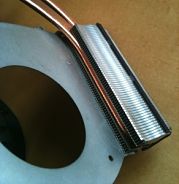
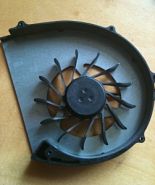 After brushing away most of the dust build-up, I gave the heatsink fins and the fan a good blast with compressed air.
After brushing away most of the dust build-up, I gave the heatsink fins and the fan a good blast with compressed air.
This blew away the last remnants of dust, and left a nice clean shiny heatsink grill and fan.
All that remained was to reassemble the laptop using the same steps as before, except in reverse.
The laptop is now working well and no longer overheats or shuts off by itself. A side-benefit of this fix is that the laptop now runs a lot more quietly.
Because the fan can now remove the excess heat in the laptop while running at a slower speed, it reduces the fan noise. The laptop is also a lot cooler to the touch.
So this overheating laptop is fixed and working perfectly again.
I have an HP Envy dv6 Notebook PC (first off, don’t get HP. I’ve had 2 laptops in the last 6 years and they break down very quickly), and this started to happen after I used a cleaning duster to get the dust out of my laptop. Maybe it moved something slightly, or maybe this was going to happen anyway and the timing was a coincidence.
yes , I often get a case , laptop power shutdown, because the fan dusty . so what you’re saying is true , writing is very helpful .. ..
I have HP probook 4510s laptop.its fan spin very fastly.and there is dust particles in the grill.after sometime the motherboard will heat and shut down.Doe’s anybody has any idea regarding this problem please help me
sorry a typing mistake
there is no dust particles in the grill
pls i have HP2000 laptop the vga on board over heat n system shut down immediately. whats the posible solution. i have service the cooling fan already
Good article, thanks! I’d been having problems with my laptop shutting down for months, I put together a hacky solution but it still did it every now and then. I took the cover off and removed the heatsink to find a large wad of dust and cat hair stuck inside the fan, and also the thermal compound on the heatsink had solidified. I cleaned off the old stuff, put some new thermal paste on and cleaned the dust from the fan and voila, the laptop hasn’t shut down since!
I have a HP pavilion dv4 laptop . it has a heating problem around its hard disk area. The is working fine. Doe’s anybody has any idea regarding this problem please help me
Cooling fan is working fine
It worked for me too. After reading this article, Ive stripped the cover and just cleaned the fan vent. Now it works fine with good sound.
The one sure reason for heating problem is the hard disk. I am using a Toshiba laptop. It was working fine. No heating problem. But one day my hard disk showed problems. So I had to replace it. The new hard disk I bought and installed was Hitachi 500GB (made in thailand). After that my laptop started getting heated and the fan started making noise. Then if I used my laptop for longer hours it switched off on its own. At first the laptop had a original Toshiba hard disk, but the new Hitachi 500 gb hard disk has problems. So if this is your’s case too then please dont buy the Hitachi hard disk. Search for your laptop’s original hard disk first.
i do recommend to follow the manufacture’s guidance before you make an attempt to disassemble your laptop’s cooling system… Thanking you all for your comments by the way…
@riyasrosy
you are so so welcome
Pingback: Fix Fix Computer Overheating Errors - Windows XP, Vista & Windows 7, 8
Pingback: Fix Fix Computer Keeps Shutting Down Errors - Windows XP, Vista & Windows 7, 8
Thanks for the tips! This is true.
I just blow air by mouth into the Laptop fan fins.
Dust came out. I did several times and Laptop problem was fixed!
Great article! Thanks for tips!!
I experienced shut down due to over-heating twice with my HP Pavilion dm4. The service manual instructed to remove several components before I can get to the heat sink.. But I decided to try an easy way first. I shut down my laptop. I used a house vacuum with a crevice tool and vacuum the heck out of the air intake and the air vent. Now the heat sink area is cool to touch. I would do this once every 3 months. In addition, I am using a Targus Chill Mat to help cool down the bottom of my laptop.
Thanks a lot for this article. I have a Dell Vostro 3700 with the same overheating problem. I am going to try your solution.
Hey, I have a Dell Vostro 3700 just like yours and its suffering the same thing. I disassembled the laptop myself using the dell service manual (im 13 btw). Just as you said, there were some bits of dust on the fan. so i used cotton buds to remove them. I havent checked the results yet but i think it’ll work just fine. thanks for the tip. appreciated.
@Erwin
Dell provides a manual for dissembling your Laptop down to the cooling
system:
http://support.dell.com/support/edocs/systems/vos3700/en/SM/Heatsink.htm
Just follow all steps until step 12 (step 4 is actually not required!) then
open up the fan part of the cooling bridge and vacuum it. It’s not actually
that hard! All you need is a medium-size Phillips screwdriver (~4mm) for
getting to step 12 and a tiny one (1-2 mm) for opening the fan. It’s well
documented and doable within an hour. Good luck!
As a temporary measure: Updating your BIOS will help too:
http://www.dell.com/support/drivers/de/de/dedhs1/DriverDetails?driverId=HWTCT&fileId=2731113448
well i have a laptop toshiba satelite L670-1LP and its overheats alot its gets soo hot that i cant use my keybord or my mouse can some one help me what to do i think soon it will burn the cpu or the video chip
Pingback: Anonymous
A friend of mine disassembled my laptop (Toshiba Equium A300D) a few months ago but didn’t find any blockages. My laptop is still overheating and shutting off. It makes a lot of noise before it turns off so it sounds like the fan still works.
What could be the cause of this? It’s really annoying. I can’t watch youtube videos, play games, install certain updates, etc.
i have lenovo laptop is this not working clearing
when starts the window it start the loading and does’nt open anything >>>> nw wt can i do please HELP ME
Thanks! That was it. (The heat sink in your picture looks clean next to what I found out in my laptop! It look as if somebody lost his toupe in there!
One of the things that I know is to place your desktop or laptop on a very air conditioned place, another is to change your fan and last there are some parts that really requires replacement might be on the verge of exploding. But I would suggest to replace all laptop parts that are slow functioning.
Thanks for providing this solution, i was think that it occur only in my laptop.
thanks.i thought that this problem only existed in my dell
there are other dell suferers too
i have dell laptop i have purchased new recently just before 3 months i m using net and while using it shut down but when i don’t use net like apart from net i used something other then it doesn’t shut
I have had the same problem twice now on my Dell Vostro 3700 and even though this sorts it, it will happen again. The only solution I have found to prevent this is to cover the air intake vents on the bottom with speaker cloth or special dust traping material which can be found at most PC shops. This can prevent the dust from getting in again, causing you to have to strip the laptop again.
this is what i did to my hp dv6-6100se when it started overheating in a room tem above 30 degree
it was helpfull to me and now when i am writting this it has been almost 2 hour but there is no hot air no spinning fan no and nothing
take a look here
http://www.helpowl.com/q/Hewlett-Packard/Paviliondv66100/Technical-Support/hp-dv66100se-amd-quad-core/173310
my laptop automatically power off…. continuously ,
Well done, mate!
I have also a Dell Vostro 3700 and I have got some overheating problems. I am considering opening my notebook, but I am scared because I might “destroy” it.
So, after you remove the back side, what do you remove then? The hard drive? And after that? Sorry, Dell doesn’t tell you how to remove everything…
thx
yea its well constructed…….thumbs up!!!
Thank you for this tips. I am actually needing this one in ventilating my laptop.
I like these tips on fixing an overheating laptop. I find lots of dust and dirt inside the fans when taking apart laptops also. Another common problem that I have seen is that in some HP laptops, the heatpipe is too small or it doesn’t cover a large enough surface area. This causes the heat to build up on the graphics chip (VPU) or on the processor (CPU) heatsink. Often times, a remedy for this, is to find a decent strip of metal to replace the small or nonexistent metal plate that goes over this. You can also find a decent thermal paste and then cover up the chip with that, be careful not to put too much on there though. This could cause a short in the system. Just a small dab of the thermal paste is usually sufficient.
Very helpful article and well written, cheers
You’ve got great insights about pcs and laptops, keep up the good work!